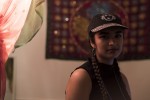Khushboo Kataria Gulati lights an off-white candle and passes the flame to a switch of sage, casting a spell around the purple-lit room as she places paintbrush to canvas. The herbaceous smoke billows around her, time suspends and her paint strokes create a scene of three multicolored faces surrounded by plants.
Her acrylic paints, she said, are the potions that allow her to conjure different worlds. The moon, a source of inexplicable comfort for Gulati, can be seen through the slits of her window blinds. She paints through the night and falls asleep when the sun appears.
She is a self-identified femme art witch.
Gulati, a fourth-year world arts and cultures student, is preparing for a show called the No Shade Art Show, which will open Feb. 27 at the Hardware Studio in Los Angeles. Her artwork is guided by the themes of self-expression, the moon and feminine energy.
Gulati said the relationship between feminine energy and creativity has played a part in her life since childhood. Eight-year-old Gulati inhaled the pungent fumes of henna as her mother darkened the tips of her daughter’s fingers with the plant-based dye in preparation for a nighttime ceremony.
Largely due to her mother’s influence, she became fascinated by the artistic elements of her Punjabi heritage, like the adornment of bare hands.
But when she enrolled in a magnet program in high school that she said lacked diversity, Gulati entered into what she calls the assimilationist period of her life. She said it was a time of trying to blend in by dressing and talking like the students surrounding her. She attempted to harmonize with Western notions of beauty, choosing not to wear embroidered shawls and kurtas – traditional Indian dress.
[gmedia id=44]
Images of fair-skinned Bollywood actresses and a lack of Indian representation in the American media intensified the pressure she felt to distance herself from her roots.
Gulati felt shame associated with her brown complexion and thick hair, prompting her to only embrace her Punjabi heritage in the privacy of her home. She was uncomfortable sharing that side of herself with schoolmates.
“(I was) surrounded by messages of self-hate reinforced,” Gulati said.
When she transferred to a humanities high school in the 10th grade, art became intertwined with political activism for Gulati.
A part of Gulati’s morning ritual is taking a political stance. Each day, the first canvas she decorates is her body. She might combine an old silver Indian necklace and a pair of black Doc Martens. Her clothing choices meticulously intertwine her Punjabi heritage with Western culture.
Amara Green, a fourth-year world arts and cultures student and Gulati’s apartment-mate, said Gulati is an artist by the way she dresses.
“Aesthetics are very political,” Gulati said. “Being intentional about it is important.”
In class, Green watches as Gulati doodles. Sometimes she sketches ideas that she will elaborate on when the moon comes out.
While Gulati’s art manifests casually from doodles, deeper inspirations also come from the events of her life, including experiences with tragedy.
Her partner, who she said was an important part of her artistic process, died in 2013. She said he was always loving and supportive and did not pass judgment on her work. He was also an artist and activist who shared many of the same political views as Gulati.
This was a tender time, Gulati said, and she released her emotions through art, particularly with him as the subject.
She created a mixed-media piece using spray paint, acrylic paint and markers only a couple days after his death, using a picture of him as the piece’s base. Through this process, she began to confront the reality of his death.
“(Art is) a place to release suppressed trauma … art affirms life,” Gulati said. “In moments of defeat or moments of feeling low … it reminds me that there is more than this and hard moments pass.”
The following year, she completed a political piece, called “Brown and Lovely,” initially painted on two wooden boards. The title plays on the words “Fair and Lovely,” a brand of skin-lightening cream popular among South Asian communities.
She was faced with the underrepresentation of dark-skinned Indians in the media and criticism from extended family who did not see her brown skin as lovely, said Preyanka Kataria Gulati, her sister.
“Brown and Lovely” is a self-celebration piece that Gulati said connects her personal story to a larger conversation about the stigma surrounding brown skin tones. She said it is political art that resists the framing of brown-skinned people as less than human. The piece was recently displayed at the Think Tank Gallery.
Through her work, Gulati said she is spotlighting anti-blackness within the South Asian community and will continue to make activist art that represents herself and others like her.
“My art practice came from making imagery that I needed to see growing up,” Gulati said. “Art is … being the person I’ve been waiting for.”

She’s incredibly talented. Her work is amazing.